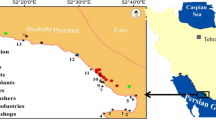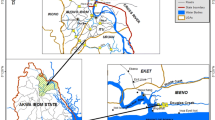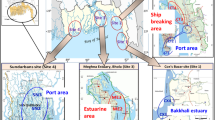Abstract
Nine locations in Shantou coastal waters were chosen for the study on contamination and ecotoxicology risks posed by polycyclic aromatic hydrocarbons (PAHs). Sediment samples were collected to investigate PAH distribution behaviour, sources and understand their origin, which is fundamental in predicting their subsequent behaviour. Many approaches and methods were applied to accomplish these objectives and study purpose. The results found revealed the critical importance of improving our understanding of PAH equilibrium relationships. The serious environmental and health concern, imposed by the high concentrations of PAHs in the area, were widely discussed. Furthermore, the location of Shantou within the town and vicinity of Guiyu, which is a booming E-waste processing centre in China, might explain the significance of atmospheric transportation source of PAHs and enhance the occurrence of air–water exchange.


Similar content being viewed by others
References
Baumard P, Budinski H, Michon Q, Garrigues P, Burgeot T, Bellocq J (1998) Origin and bioavailability of PAHs in the Mediterranean Sea from mussel and sediment records. Estua Coast Shelf Sci 47:77–90. doi:10.1006/ecss.1998.0337
Berner BA, Bryner NP, Wise SA, Mulholland GH, Lao RC, Fingas MF (1990) Polycyclic aromatic hydrocarbon emissions from combustion of crude oil on water. Environ Sci Technol 24:1418–1427. doi:10.1021/es00079a018
Canadian Council of Ministers of the Environment (CCME) (1999) Canadian sediment quality guidelines for the protection of aquatic environment. Canadian environmental quality guidelines. CCME, Winnipeg, Ontario
Chapman PM (1989) Current approaches to developing sediment quality criteria (review). Environ Toxicol Chem 8:589–599. doi:10.1897/1552-8618(1989)8[589:CATDSQ]2.0.CO;2
Chapman PM, Wang F, Germano JD, Batley G (2002) Pore water testing and analysis: the good, the bad, and the ugly. Mar Pollut Bull 44:359–366. doi:10.1016/S0025-326X(01)00243-0
Department for Environment, Food and Rural Affairs (DEFRA) (2002) The effects of polycyclic aromatic hydrocarbons on human health. http://www.defra.gov.uk/environment/airquality/aqs/poly/5.htm. Accessed 31 July 2006
Gschwend PM, Hites RA (1981) Fluxes of polycyclic aromatic hydrocarbons to marine and lacustrine sediments in the northeastern United States. Geochim Cosmochim Acta 45:2359–2367. doi:10.1016/0016-7037(81)90089-2
IARC (2002) Monographs database on carcinogenic risks to humans, November 2002. http://monographs.iarc.fr/ENG/Classification/index.php. Accessed 31 July 2006
Hartmann PC, Quinn JG, Cairns GW, King JW (2004) The distribution and sources of polycyclic aromatic hydrocarbons in Narragansett Bay surface sediments. Mar Pollut Bull 48:351–358. doi:10.1016/j.marpolbul.2003.08.014
MacDonald DD, Carr RS, Cader FD, Long ER, Ingeroll CG (1996) Development and evaluation of sediment quality guidelines for Florida coastal waters. Ecotoxicology 5:253–278. doi:10.1007/BF00118995
MacDonald DD, Ingeroll CG, Berger TA (2000) Development and evaluation of consensus based sediment quality guidelines for freshwater ecosystems. Arch Environ Contam Toxicol 39(1):20–23. doi:10.1007/s002440010075
Maher WA, Aislabie J (1992) Polycyclic aromatic hydrocarbons in near shore marine sediments of Australia. Sci Total Environ 112:143–164. doi:10.1016/0048-9697(92)90184-T
Maskaoui K, Zhou JL, Hong HS, Zhang ZL (2002) Contamination by polycyclic aromatic hydrocarbons in the Jiulong River estuary and Western Xiamen Sea. Environ Pollut 118:109–122. doi:10.1016/S0269-7491(01)00208-1
Maskaoui K, Hu Z, Zhou JL, Han YL (2006) Levels of polycyclic aromatic hydrocarbons in some agricultural, industrial and urban areas along Xiamen coastal waters, China. J Environ Sci 18(2):318–322
Mitra S, Dellapenna TM, Dickhut RM (1999) Polycyclic aromatic hydrocarbon distribution within lower Hudson River estuarine sediments: physical mixing vs sediment geochemistry. Estuarine. Coast Shelf Sci 49:311–326. doi:10.1006/ecss.1999.0502
Muel B, Saguem S (1985) Determination of 23 polycyclic aromatic hydrocarbons in atmospheric particulate matter and of Paris area and photolysis by sunlight. Int J Environ Anal Chem 19:111–131. doi:10.1080/03067318508077022
Naes K, Axelman J, Naf C, Broman D (1998) Role of soot carbon and other carbon matrices in the distribution of PAHs among particles, DOC and the dissolved phase in the effluents and recipient waters of an aluminium recycling plants. Environ Sci Technol 32(12):1786–1792. doi:10.1021/es9708732
Neff JM (1979) Polycyclic aromatic hydrocarbons in the aquatic environment: sources, fates and biological effects. London, UK, Applied Science Publishers, p 262
Readman JW, Filman GI, Bartocci J, Villeneuve JP, Catinni C, Mee LD (2002) Petroleum and PAH contamination of the Black Sea. Mar Pollut Bull 44:48–62. doi:10.1016/S0025-326X(01)00189-8
Rogers HR (2002) Assessment of PAH contamination in estuarine sediments using the equilibrium partitioning-toxic unit approach. Sci Total Environ 290:139–155. doi:10.1016/S0048-9697(01)01079-8
Simpson CD, Mosi AA, Cullen WR, Reimer KJ (1996) Composition and distribution of polycyclic aromatic hydrocarbons contamination in surficial marine sediments from Kitimat Harbor, Canada. Sci Total Environ 181:265–278. doi:10.1016/0048-9697(95)05026-4
Soclo HH, Garrigues P, Ewald M (2000) Origin of polycyclic aromatic hydrocarbons in coastal marine sediments: case studies in Cotonou (Benin) and Aquitaine (France) areas. Mar Pollut Bull 40:387–396. doi:10.1016/S0025-326X(99)00200-3
Song YF, Jing X, Fleischmann S, Wilke BM (2002) Comparative study of extraction methods for the determination of PAHs from contaminated soils and sediments. Chemosphere 48:993–1001. doi:10.1016/S0045-6535(02)00180-7
Vyskocil A, Fiala Z, Chenier V, Krajak L, Ettlerova E, Bukac J, Viau C, Emminger S (2000) Assessment of multipathway exposure of small children to PAH. Environ Toxicol Pharmacol 8:111–118. doi:10.1016/S1382-6689(00)00032-6
Wang XC, Zhang TX, Chen RF (2001) Distribution and partitioning of polycyclic aromatic hydrocarbons (PAHs) in different size fractions in sediments from Boston Harbour, United States. Mar Pollut Bull 42:1139–1149. doi:10.1016/S0025-326X(01)00129-1
Webster L, McIntosh AD, Moffat CF, Dalgarno EJ, Brown NA, Fryer RJ (2000) Analysis of sediments from Shetland Island voes for polycyclic aromatic hydrocarbons, steranes and triterpanes. J Environ Monit 2:29–38. doi:10.1039/a907556i
Wise SA, Benner BA, Byrd GD, Chesler SN, Rebbert RE, Schantz MM (1988) Determination of polycyclic aromatic hydrocarbons in a coal tar standard reference material. Anal Chem 60:887–894. doi:10.1021/ac00160a012
Woodhead RJ, Law RJ, Matthiessen P (1999) Polycyclic aromatic hydrocarbons in surface sediments around England and Wales, and their possible biological significance. Mar Pollut Bull 38:773–790. doi:10.1016/S0025-326X(99)00039-9
Yang HH, Lai SO, Hsieh LT, Hsueh HJ, Chi TW (2002) Profiles of PAH emission from steel and iron industries. Chemosphere 48:1061–1074. doi:10.1016/S0045-6535(02)00175-3
Zhou JL, Maskaoui K (2003) Distribution of polycyclic aromatic hydrocarbons in water and sediments from Daya Bay, China. Environ Pollut 121:269–281. doi:10.1016/S0269-7491(02)00215-4
Zhou JL, Hong HS, Zhang ZL, Maskaoui K, Chen WQ (2000) Multiphase distribution of organic micropollutants in Xiamen Harbour, China. Water Res 34:2132–2150. doi:10.1016/S0043-1354(99)00360-7
Acknowledgments
This work was supported by Fork Ying Tong Education Foundation (No. 94002), National Science Foundation of China (No. 40206015) and Science & Technology Project of Guangdong Province, China (No. 2005B33201008).
Author information
Authors and Affiliations
Corresponding author
Rights and permissions
About this article
Cite this article
Maskaoui, K., Hu, Z. Contamination and Ecotoxicology risks of Polycyclic Aromatic Hydrocarbons in Shantou Coastal Waters, China. Bull Environ Contam Toxicol 82, 172–178 (2009). https://doi.org/10.1007/s00128-008-9522-6
Received:
Accepted:
Published:
Issue Date:
DOI: https://doi.org/10.1007/s00128-008-9522-6




